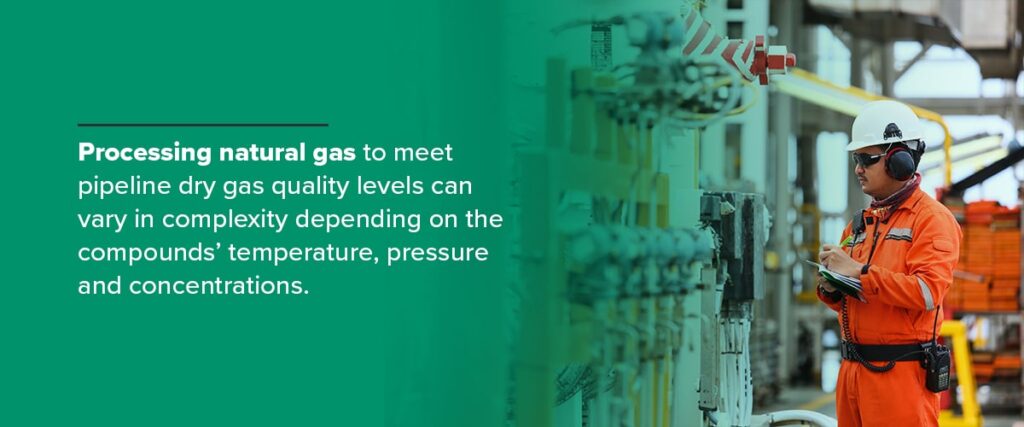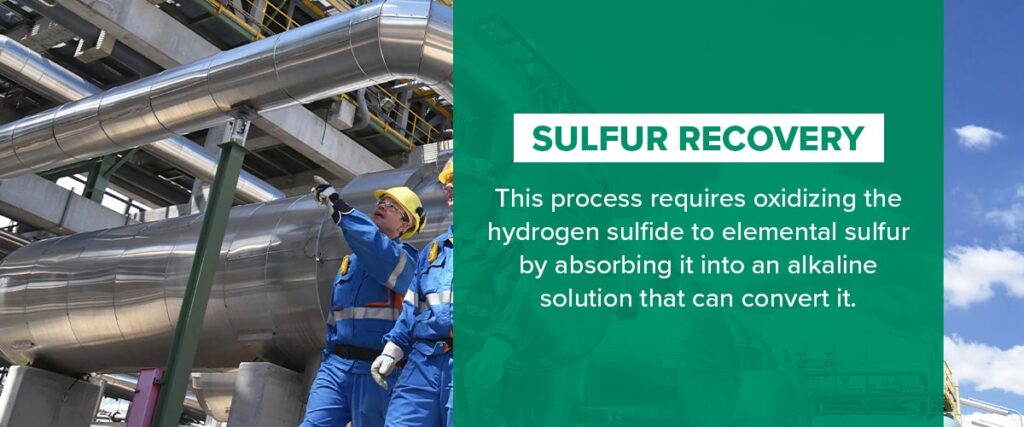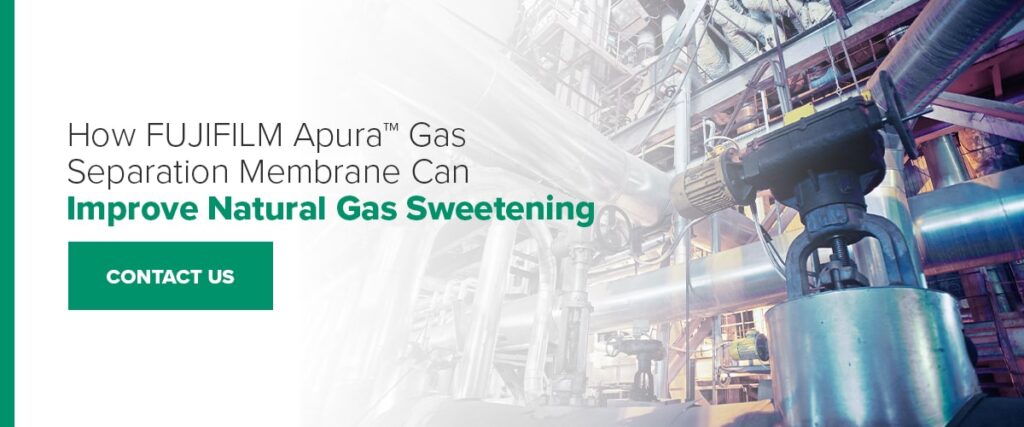
Jump to:
- How Does Natural Gas Form?
- How Is Natural Gas Processed?
- Why Is Natural Gas Sweetening Important?
- Natural Gas Sweetening Methods
- What Are Some Operating Problems That Can Occur When Treating Sour Gas?
Natural gas must meet strict quality requirements before it can be used. Natural gas will always have a certain level of contamination. The gas is classified as either sweet or sour, depending on the contaminants present.
Sweet gas tends to have a heating value that makes it preferable for sale and transport, while sour gas must go through further purification and refining. In this article, we’ll review the steps in the natural gas sweetening process, different methods and why specific contaminants must be removed to meet transport and market specifications.
How Does Natural Gas Form?
Natural gas comes from underground reservoirs of decomposed organic matter deposited over the last hundreds of millions of years. This carbon and hydrogen-filled organic matter, subject to pressure and heat, changed into coal, oil and natural gas.
Over time, organic material was gradually buried under mud, sand and seawater. A thermal breakdown began as the material was sealed in an oxygen-free environment and exposed to increasing pressure and heat. This process converted the organic matter into hydrocarbons, which exist in a gaseous state. Natural gas is a mixture of several hydrocarbon gases, primarily methane, a simple, light, highly flammable hydrocarbon.
Natural gas also contains impurities, such as hydrogen sulfide, nitrogen and carbon dioxide. These contaminants must be removed from the natural gas before it can be transferred to commercial applications or pipeline gas transmissions.

How Is Natural Gas Processed?
Gas sweetening is the step that removes acidic impurities like carbon dioxide and hydrogen sulfide. Processing natural gas to meet pipeline dry gas quality levels can vary in complexity depending on the compounds’ temperature, pressure and concentrations. Treatment can include many different methods but always involves a chemical or physical process to separate compounds from natural gas to make it saleable and useable for humans.
Removing Sulfur and Sweetening the Gas
Acid gas is natural gas containing impurities like hydrogen sulfide. At this point in the process, the natural gas must be sweetened by removing mostly hydrogen sulfide and carbon dioxide. If these acidic gasses are put into a pipeline, they can corrode the inside and cause stress cracking.
While hydrogen sulfide is sometimes removed from the sour gas using membrane technology, removal often occurs using solutions known as amines. The use of amines to ensure that natural gas can meet quality specifications is why the gas sweetening process is sometimes called amine s crubbing or amine treating. Some amines used in natural gas sweetening include:
- Diethanolamine
- Monoethanolamine
- Methyl diethanolamine
- Diglycolamine
During this process, the sour gas and lean amine are combined in a contactor tower to create an acid-base reaction. This reaction occurs because the natural gas contains a higher concentration of acid gases, allowing the amine solution to absorb them. Once this happens, a ‘sweet’ gas with low levels of acidic gas remains. The amine solution, including acid gasses, flows into a regenerator.
Here, the tower supplies heat to break down the weak bond between the acid gas and amine, releasing the acid gas. The gas containing a high concentration of acid compounds will rise to the top of the regenerator and flow out for further treatment. Meanwhile, the lean amine is recirculated back into the contactor tower for reuse.
Separating Water
One of the most important elements of gas treatment is establishing dehydration. This process removes water vapor. Too much water left in a pipeline may lead to hydrates forming, which can slow or even stop a pipeline from flowing. This step is typically required before the natural gas can be sold for commercial use or pipeline marketing.

Sulfur Recovery
Once the gas sweetening process takes place, the result is a gas product that no longer has the strong, sour odor of hydrogen sulfide and other impurities. The improved smell gives the natural gas its “sweetened” properties. However, this process does not recover sulfur in elemental form, which means an additional stage must follow gas sweetening for sulfur recovery.
If sulfur recovery is available, then a direct conversion process would follow. This process requires oxidizing the hydrogen sulfide to elemental sulfur by absorbing it into an alkaline solution that can convert it. This oxidation process leaves behind a solution that can be regenerated.
The process is often used in petrochemical plants, natural gas processing plants and refineries.
Measuring for Pipeline Quality
The natural gas sweetening process also requires measuring hydrogen sulfide and carbon dioxide concentrations to ensure they are below the mandatory limit before the natural gas can be sold or transported in a pipeline. Accurate measurement of these contaminants is critical to optimizing the sweetening process.
Natural gas must meet environmental and equipment specifications before it’s ready to be used for commercial purposes. If there are elevated levels of hydrogen sulfide in the gas, it can create severe consequences in the processing plant and downstream operations. Releasing off-spec gas can lower the life span of the pipes connecting the plant and export utility. It can also result in hefty fines for failing to meet environmental and toxicity standards.
Why Is Natural Gas Sweetening Important?
In addition to removing impurities and corrosion control, gas sweetening is also essential for:
- Meeting gas and liquid product specifications.
- Preventing toxicity and poisoning.
- Controlling the heating value.
- Meeting environmental requirements.
- Reducing contact with bacteria.
- Preventing water and carbonic acid from forming together.
- Meeting feedstock quality requirements.
Removing hydrogen sulfide from natural gas is also essential for eliminating harmful fumes. At concentrations of 100-1,000 parts per million (ppm), hydrogen sulfide can even cause instant death from a single breath. Sales gas specifications typically require the hydrogen sulfide content to be less than 4 ppm to prevent extreme toxicity.
High concentrations of carbon dioxide can lower natural gas’s high heating value. Carbon dioxide must also meet sales gas requirements and stay within a specific range before creating unsafe operational conditions.
While the primary concern during natural gas sweetening is to remove acid gases, other sulfuric compounds must be removed from the process gas, including:
- Thiols derived from hydrogen sulfide
- Carbonyl sulfide
- Carbon disulfide
Removing these contaminants is also critical to prevent freezing issues and comply with environmental regulations to control corrosion and emissions.

Natural Gas Sweetening Methods
The sweetening of natural gas is one of the most critical steps in gas processing. There are many different processes for sweetening gas. Because the carbon dioxide and hydrogen sulfide concentrations in raw gas will always vary, no single process works uniformly for natural gas sweetening. Many techniques are sometimes used simultaneously or sequentially to achieve allowable acid gas levels:
- Batch solid bed absorption removes hydrogen sulfide at low concentrations.
- Reactive solvents remove large concentrations of hydrogen sulfide and carbon dioxide and then reuse the solvents.
- Physical solvents remove carbon dioxide while regenerating solvents like Fluor, Purisol, Selexol and Recitisol.
These acid gas removal processes primarily fall into two types:
- Absorption is achieved by reaction through chemical means or dissolution by physical means.
- Adsorption is achieved through a process in which impurities are removed from the gas using concentration onto a solid surface, known as a physical-chemical phenomenon.
Within these methods, various factors can influence the selection of a given sweetening treatment process, such as:
- Operating and capital costs
- Type and concentration of impurities
- Presence of heavy aromatic in the natural gas
- Hydrocarbon composition of gas
- Inlet and outlet acid gas concentrations
- Specifications for the acid and residue gas
- Feasibility of sulfur recovery
- Environmental considerations
- Relative economics
- Temperature, pressure and flow rate of the sour gas and how it must be delivered
- Air pollution regulations for gas clean-up requirements and sulfur compound disposal
The most commonly used method for sweetening natural gas is reactive solvents, like the amine example described above. This method is generally used for bulk removal of contaminants because of its low operating cost and ability to tailor solvent compositions to suit natural gas. Liquid physical solvents can also be used to improve selectivity.
However, the operating conditions of this method depend on the type of amine. While primary amines react strongly to acid gases, they form stable bonds. Unlike the weak bonds between acid gas and amine that break down in the contactor tower, strong bonds are difficult to work with in this method.
Secondary amines are more easily recovered and have a reasonable capacity for acid gas absorption. Lastly, tertiary amines have the lowest capacity but are more selective for hydrogen sulfide absorption.
In addition to the amine processes, natural gas sweetening utilizes heaters and scrubbers. The heaters control the gas’s temperature and ensure it doesn’t drop too low. If the temperatures are cold enough, natural gas that contains even the smallest amount of water tends to form solid, icy crystals called natural gas hydrates. These hydrates can eventually accumulate, block the valves and passages in processing systems and create operational problems.
Scrubbers also prevent such issues. They help remove large particles and other impurities like sand to speed up the purification process.
Once the pipeline-quality natural gas has been processed, it gets injected into gas transmission pipelines. From there, it will be transported hundreds of miles to the end-users for commercial sale.
What Are Some Operating Problems That Can Occur When Treating Sour Gas?
Treating natural gas with varying concentrations of different compounds can be a challenge. Many problems can occur during the natural gas sweetening process when using chemical solvents, including solvent loss, solution foaming and failure to meet the hydrogen sulfide requirements for sales gas.
Solvent Loss
In regenerative solvent systems used for natural gas sweetening, solvent loss will always occur after operation. Adding pure solvent to the solution will help restore the necessary chemical balance, which can be altered by:
- Vaporization.
- Entrainment.
- Degradation and removal of degradation products.
- Mechanical losses.
The solvent’s vapor pressure will increase as the temperature rises when treating gas. In the gas sweetening system, gas and liquid streams separate through the contactor, flash tank and reflux drum. A water wash process can help prevent solvent loss in these systems. Some systems that rely on primary amines may need special separation equipment to remove degradation of the solvent before it leads to corrosion.
Other mechanical issues leading to solvent loss include drips from pumps, vessel cleaning and draining and filter problems.
Solution Foaming
Solution foaming results from gas getting trapped as bubbles in the liquid. The forming bubbles will decrease the solution’s surface tension, interfering with sour gas treatment. Solution foaming is usually caused by:
- Compressor oil.
- Liquid hydrocarbons entering the contactor with the sour gas.
- Fine solid suspensions such as iron sulfide.
- Acidic amine-degradation products.
- Treating chemicals from wells or gathering systems.
- Treating chemicals from makeup water.
This foaming can create severe operational issues in the process tower, leading to loss of chemicals and causing damage to materials and process equipment. The contactor tower must be free of condensed liquids before the sour gas enters the system in order to prevent solution foaming. The leftover solution should always be cleaned with carbon filtration afterward.
Exceeding Hydrogen Sulfide Limits
Treated gas with a hydrogen sulfide content above the regulated standards is not admitted into sales-gas transmission lines. Several factors can lead to this condition, including:
- Changes in feed gas temperature.
- Changes in the acid gas concentration of feed gas.
- Insufficient contact in the absorber.
- Overheating the lean amine solution.
- Insufficient amine circulation rates.
- Inadequate solution regeneration.
- Inadequate solvent concentration in the solution.
- Insufficient absorber pressure.
- Excessive degradation product concentrations or inlet gas rates.
- Foaming or mechanical damage.
How FUJIFILM Apura™ Gas Separation Membrane Can Improve Natural Gas Sweetening

At Fujifilm, we have worked hard to innovate and develop a highly functional membrane element for gas separation. With Apura™, sweetening natural gas has never been easier, more efficient or cost-effective. FUJIFILM Apura™ gas separation membranes can be used for bulk and fine removal of acid gas by maximizing carbon dioxide removal capacity and hydrocarbon recovery.
Based on our experience in manufacturing, thin-film coating and organic chemistry, we are able to offer our clients a treatment that provides high performance and strength against contaminants that disrupt pipeline quality gas, such as water and aromatics. Using our multilayer composite membrane technology, you can be confident that your plant operations will benefit from reduced emissions and more efficient processes.
To learn more about our natural gas sweetening technology, contact us today or read online about our advancements in the gas and water industry.













